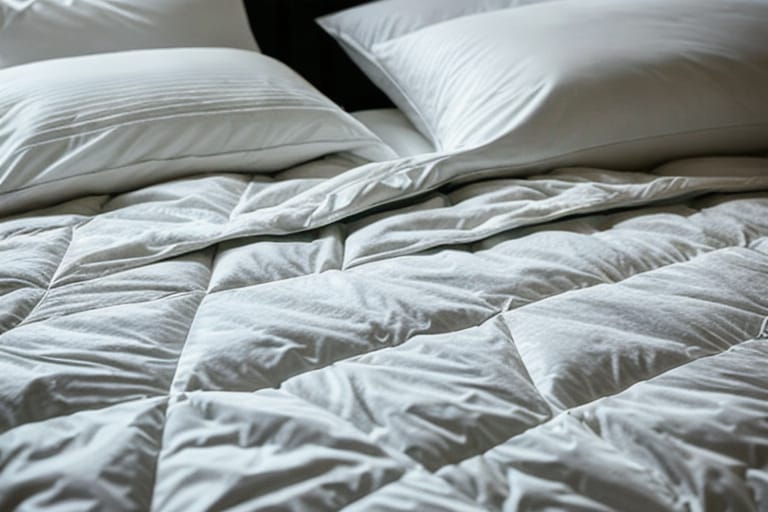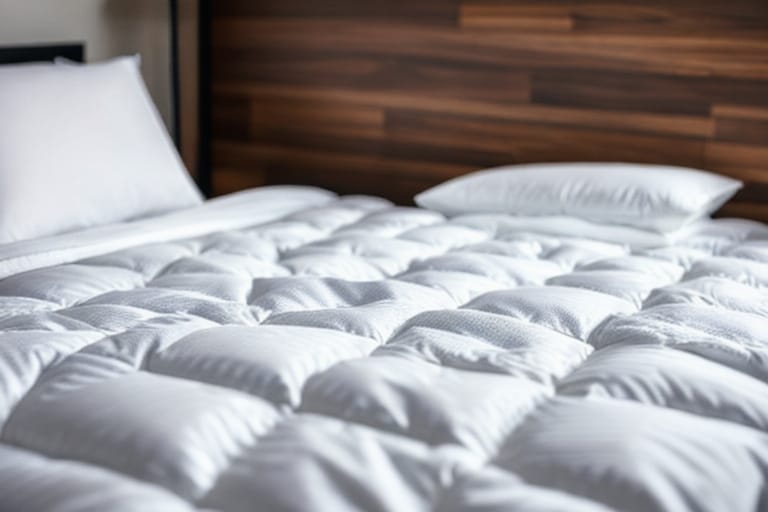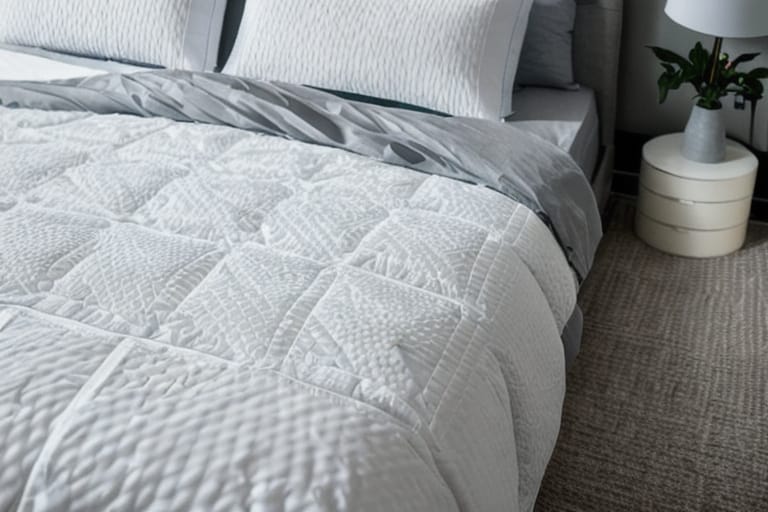Comforters are essential for many of us to get a good night’s sleep. With comforters coming in down and down alternative materials, how do you know which one is right for you? A key question buyers commonly ask is whether down alternative comforters shed like their down counterparts.
Understanding the filling and construction of different comforters is key to making an informed decision. In this beginner’s guide, we’ll compare down and down alternative comforters, looking specifically at:
- Shedding differences between down and down alternative
- Insulation and temperature regulation
- Durability and longevity
- Fill power and construction methods
- Care and maintenance related to shedding
Read on for a complete overview, so you can determine whether down alternative comforters shed based on your needs for allergy protection, breathability, and comfort.
What is a Down Comforter?
Before diving into shedding, let’s quickly define down comforters. Down comforters contain a soft, insulating fill made from the fine feathers of ducks or geese:
The down clusters provide lightweight warmth and plush comfort for sleepers. Higher fill power ratios mean more fluffiness from larger down clusters.
Goose down tends to provide better insulation than duck down. Down comforters have natural breathability to adapt to temperatures, though they are very warm. They can be expensive and require delicate care.
Now, how does this differ from a down alternative comforter?
Understanding Down Alternative Comforters
A down alternative comforter uses synthetic fills instead of natural down. Common alternatives include:
- Polyester fiberfill – Most budget-friendly
- Microfiber fill – Extremely soft and mimics down well
- Rayon made from bamboo– Breathable and moisture-wicking
These synthetic fills mimic attributes of down like fluffiness. But they shed less, are hypoallergenic, and are often cheaper.
On the downside, down alternatives don’t breathe as well, so they can get hot for summer. They’re also less durable over decades of use compared to quality goose down.
Now, let’s dive into the central question:
Differences: Do Down Alternative Comforters Shed?
A common belief is that all comforters will leak some fill and shed over time. So do down alternative options shed less than regular down comforters?
The short answer is:
Down alternative comforters shed significantly less than down comforters over the short and long term.
But why is that the case?
Why Down Comforters Shed More
There are a few reasons why down comforters are prone to moderate shedding:
- The natural down feathers are very fine and designed to come loose for insulation purposes. This means they can slowly poke through the outer shell no matter how finely woven.
- Lower thread counts and looser stitching allows feathers to gradually escape. Many cheaper down comforters suffer from this.
- Over 5+ years, down will slowly break down, clump, and leak out from small holes in the shell. Proper maintenance and storage can reduce this deterioration and extend longevity.
So if you see a few white feathers on your bedroom floor after making the bed, it’s perfectly normal for a down comforter!
Less Shedding in Down Alternative Fills
Meanwhile, quality down alternative comforters shed negligibly because:
- Synthetic microfibers and polyester filaments are finer than down feathers so they don’t poke through the shell as easily.
- Manufacturing methods like quilting and channel stitching better contain synthetic fills.
- Not degrading as readily as down, most down alternative materials maintain their structure much longer with less shedding occurring over decades of use.
While no comforter can prevent shedding 100%, down alternative options come extremely close when you choose the right quality and construction:

How Insulation and Durability Compare
Beyond shedding differences, two factors that may influence your choice between down and down alternative comforters are insulation performance and durability over decades.
Down Wins on Insulation Power
For pure temperature regulation, down comforters excel due to the loft created by larger feather clusters trapping body heat.
As the chart shows, higher fill powers above 600 provide excellent insulation, heat retention, and breathability during sleep:
| Fill Power | Insulation Rating |
|---|---|
| Under 500 | Fair |
| 600-650 | Very Good |
| 700+ | Excellent |
While advances in synthetic fills better emulate down, most down alternative comforters can’t quite match the consistent warmth-to-weight ratio over years of use.
Long-Term Durability Favors Down
Over 5-10+ years however, a well-made goose down comforter will likely outlast cheaper down alternatives that flatten and degrade over time:
- Quality European white down maintains loft and structure for potentially decades with proper care. This means long-lasting warmth and minimal cold spots.
- Inferior down alternative materials break down faster through clumping and pilling. So you lose fluffiness and warmth necessitating replacement sooner.
So evaluates your timeframe – are you prioritizing next winter’s performance or investment over 10+ years? Your needs influence whether down or down alternative makes most sense.
Comparing Care and Maintenance
To minimize shedding as much as possible, investing a little time into comforter care and maintenance pays off substantially over years of consistent sleep comfort.
Between down and down alternative, some key differences exist:
| Care Task | Down Comforter | Down Alternative Comforter |
|---|---|---|
| Washing Frequency | 1-2 times per year max | 3-4 times per year |
| Drying Method | Air dry flat | Machine dry low |
| Dry Cleaning | Recommended | Rarely needed |
| Fluffing | Frequent fluffing needed | Occasional fluffing sufficient |
The less frequent washing, air drying, and careful handling reduces stress on delicate down to curtail leaking through the shell long-term.
Fluffing down comforters regularly also restores warming loft that gets compressed during sleep, directly combating shedding too.
For down alternative comforters, machine drying and washing a bit more often poses no issue. But read labels to verify cleaning guidance specific to the materials used.
What About Allergies and Ethics?
Beyond shedding, two other considerations around down vs down alternative comforters are:
- Allergies – Down requires stringent allergy precautions while down alternative remains hypoallergenic.
- Sourcing – Some object to down derived from live-plucked geese rather than ethical harvesting after death.
So if you’re sensitive to dust and feathers or want cruelty-free bedding, a down alternative filling avoids those concerns.
Synthetic fills pose no allergy or animal welfare issues relative to natural down clusters.
Expert Recommendations on Top Rated Comforters
The experts at leading review site Wirecutter evaluated dozens of down and down alternative comforters across budgets to compile their current 2023 recommendations:
Overall Best Down Comforter
- LEARN MORE – Brooklinen Down Comforter – $249+“Impressive warmth-to-weight ratio and high-quality construction make this a comfortable year-round option.”
Best Mid-Range Down Alternative
- LEARN MORE – Buffy Cloud Comforter – $160-$200“Incredibly soft, fluffy, and allergen-friendly. Great for those wanting down’s feel without the allergies or cost.”
Most Affordable Quality
- LEARN MORE – Amazon Basics Down Alternative Comforter – $47+“Surprisingly decent quality and performance rivaling brands double the price or more.”
As you evaluate options, focus first on material quality, insulation needs, and ethics based on the guidance above. With the right informed questions, retailers can direct you to long-lasting solutions too.
Common Down Comforter Myths
Despite their popularity, some common down comforter myths deserve debunking when it comes to shedding, allergies, and warmth:
Myth: All down comforters leak feathers heavily over time
Fact: While all down comforters shed slightly, quality construction minimizes leakage substantially. With reasonable care, a mid-range comforter loses minimal fill over 5 years or more.
Myth: Down filling always causes allergies
Fact: For allergy sufferers, quality down with sufficient barrier layers, high thread count, and proper maintenance may allow comfortable use.
Myth: Down doesn’t work well in warm climates
Fact: Look specifically for lightweight, summer-weight down comforters with lower fill power around 400-500. These provide warmth minus heavy insulation.
So don’t let these myths deter you from considering a down comforter if it aligns with your priorities for fluffy comfort and ethical sourcing.

Takeaways – What Did We Learn?
Choosing between down and down alternative comforters requires weighing factors like warmth, longevity, care requirements, ethics, and allergies for your individual needs.
The main highlights about down alternative comforters covered today include:
- Down alternative comforters shed much less than down over both the short and long term. They better contain fills through tighter stitching and woven shells.
- For shoppers sensitive to allergies, feathers, or animal welfare, down alternative is the safer choice requiring no special precautions.
- While down provides unbeatable insulation year after year, some down alternative materials today mimic attributes very closely at lower cost.
- Carefully review materials and construction when purchasing for highest quality minimizing shedding, debris, and allergens over 5-10 years of use.
Weigh what’s most important – breathability, ethics, budget, etc. And don’t hesitate to speak to knowledgeable comforter retailers as you evaluate options. This ensures the long-lasting comfort you seek at the right value.
Frequency Asked Questions
For those still weighing choices between down and down alternative comforters, here are answers to some frequently asked questions:
How to Identify Quality in Comforters?
Focus on fill power (down) or fill material (down alternative), thread count, and stitching methods.
- 550+ fill power down and soft microfiber fills provide the best warmth, loft and durability
- Seek 400+ thread count shells tightly woven enough to contain insulating fills
- Baffle box stitching (down) and channel quilting (down alt) prevent fill shifting over years
With quality materials and construction, both DOWN and DOWN ALTERNATIVE can minimize shedding.
What Certifications Help Identify Ethical Down Sources?
Look for down certified by Responsible Down Standard (RDS) or Downpass to ensure:
- No live-plucking or force-feeding
- Third party audits to verify animal welfare
Certification gives confidence in ethical down production and comfort without guilt!
Can I Customize Down Comforters to My Needs?
Yes! Many retailers offer custom options to tailor down comforters to your perfect size, warmth rating, and outer material preferences.
This allows personalized solutions to match sleep habits while minimizing wasted materials for sustainability.
How Often Should I Replace My Down Alternative Comforter?
Approximately every 5-8 years. Higher quality materials like primaloft or silk-enhanced microfiber maintain their insulating value for years longer than cheaper polyester.
Replace sooner if excessive flattening, clumping, or tearing occurs.
What’s the Best Way to Wash and Dry Comforters?
- Machine wash cold, gentle cycle with tennis balls using mild detergent for both
- Air dry down comforters flat
- Put down alternative comforters in low heat dryer with wool dryer balls to restore fluff
This preserves insulation, limits moisture deterioration, and prevents excess shedding long term.








